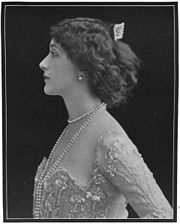Lina Cavalieri's Human Design Chart
5/1 Sacral GeneratorItalian opera soprano singer, actress, and monologist, in her time referred to as the “world’s most beautiful woman.”
She lost her parents at the age of fifteen and became a ward of the state, sent to live in a Roman Catholic orphanage. The vivacious young girl was unhappy under the strict discipline of the nuns, and at the first opportunity she ran away with a touring theatrical group.
At a young age, she made her way to Paris, France, where she obtained work as a singer at one of the city’s caf‚-concerts. From there she performed at a variety of music halls and other such venues around Europe, while still working to develop her voice. In 1900, she married her first husband, the Russian Prince Alexandre Bariatinsky. In 1904, she sang at the Op‚ra de Monte-Carlo then in 1905, at the Sarah Bernhardt Theatre in Paris, Cavalieri starred opposite Enrico Caruso in the Umberto Giordano opera Fedora. From there, she and Caruso took the opera to New York City, debuting with it at the Metropolitan Opera on 5 December 1906.
Cavalieri remained with the Metropolitan Opera for the next two seasons, performing again with Caruso in 1907, in Puccini’s Manon Lescaut. Renowned as much for her great beauty as for her singing voice (and acting ability), she became one of the most photographed stars of her time.
Her first marriage long over, she had a whirlwind romance with Robert Winthrop Chanler (1872?1930), a member of the Astor family and Dudley?Winthrop family. They married on 18 June 1910 but separated by the end of their honeymoon, and their divorce became final in June 1912. After the divorce, Cavalieri returned to Europe where she became a much-loved star in pre-revolutionary St. Petersburg, Russia, and in Ukraine. She married French tenor Lucien Muratore in 1913.
After retiring from the stage, Cavalieri ran a cosmetic salon in Paris. In 1914, she wrote an advice column on make-up for women in Femina magazine and published a book, My Secrets of Beauty. In her parisian Institut de Beaut‚, she licensed Parfums Isabey Paris and not only sold Isabey perfumes but developed in 1926 a range of beauty products and launched the same year her own perfume, apparently inspired by Leonardo da Vinci’s Mona Lisa, which she called ‘Mona Lina.’
In 1915, she returned to Italy to make motion pictures. When that country became involved in World War I, she went to the United States where she made four more silent films. The last three of her films were the product of her friend, the Belgian film director Edward Jos‚. Almost all of her films are considered lost films.
After marrying her fourth husband Paolo d?Arvanni, she returned to live with him in Italy. Well into her sixties when World War II began, she nevertheless worked as a volunteer nurse. Cavalieri was killed on 8 February 1944 during an Allied bombing raid that destroyed her home in Florence near Poggio Imperiale, where she was placed under police surveillance because of her foreign husband.
Link to Wikipedia biography
Discover More Famous People
Browse and analyze over 55,000 public figures and celebrities.
Ra Uru Hu
5/1 Manifestor
Martha Stewart
4/6 Manifestor
David Lynch
4/6 Generator
Barack Obama
6/2 Projector
Steve Jobs
6/3 Generator
Vladimir Putin
5/1 Manifestor
Michael Jackson
1/3 Projector
Kim Kardashian
3/5 Generator
Marilyn Monroe
6/2 Projector
Ariana Grande
2/4 Projector
Oprah Winfrey
2/4 Generator
Johnny Depp
2/4 ManifestorWhat is HumanDesign.ai and how does it work?
Curious what makes Lina Cavalieri tick? HumanDesign.ai instantly maps their exact birth data into a fully interactive clickable bodygraph chart, letting you hover or tap every center, channel, and gate for plain-language explanations. Bella, the platform’s built-in AI guide, adds context in real time, translating complex mechanics into everyday insights so you can see how Lina Cavalieri’s strengths, challenges, and life themes play out on-screen.
The same tools are waiting for you. Generate your own Human Design Chart in seconds, open a library of 2000+ suggested questions, and chat with Bella as often as you like to decode your design, daily transits, and even relationship dynamics.
Want to compare energies? Save unlimited charts for friends, family, or clients, then ask Bella to reveal compatibilities, composite patterns, or coaching tips, all in one conversation thread.
Start free with core features, or unlock our Personal and Pro plans for deeper dives: unlimited Q&A, celebrity chart search spanning 55,000+ public figures, white-label PDF reports, branded content generation, and a professional profile with built-in booking for practitioners. Whether you’re exploring your own potential or guiding others, HumanDesign.ai delivers an ever-expanding toolbox of AI-powered insights—no spreadsheets, no jargon, just clarity at your fingertips.
Ready to see yours? Signup for FREE today!

